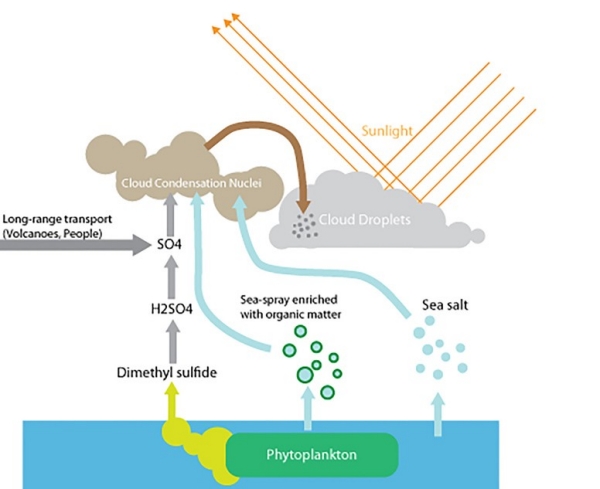Tiny Sea Organisms Help Cool The Earth

By Samba Lampich
There are few things that are more relaxing than sitting on a sunny beach or a grassy field and watching the wind gently nudge fluffy clouds across a brilliant blue sky.
But those clouds are hard at work, playing a crucial role in keeping the Earth cool. These white puffs have tiny droplets, which act as powerful deflectors of sunlight, reflecting the heat away back into space before it enters Earth’s atmosphere. And bigger clouds reflect more sunlight because they contain more tiny water droplets that reflect more sunlight. These droplets are created when water condenses onto microscopic particles and aerosols, floating in the Earth’s atmosphere.
Scientists from the Department of Atmospheric Sciences, University of Washington, Seattle wanted to find out how and what influenced the creation of these aerosols, so they turned to NASA data and used their own simulation models to find out.
In 2014, these scientists conducted a year-long study to investigate the link between planktons and clouds. The research was funded by NASA, the U.S. Department of Energy and a graduate fellowship from the Air Force Office of Scientific Research.
They studied the Southern Ocean, comprised of the southernmost waters of the Pacific, Atlantic and Indian oceans. This area is far removed from human activity, making it an ideal location to study the natural creation of clouds.
“The clouds over the Southern Ocean reflect significantly more sunlight in the summertime than they would without these huge plankton blooms,” said co-lead author Daniel McCoy, a University of Washington doctoral student in atmospheric sciences. “In the summer, we get about double the concentration of cloud droplets as we would if it were a biologically dead ocean.”
A Drop In The Ocean
The researchers found that more cloud droplets occurred over areas that had robust plankton floating in the upper sunlit areas of the ocean. These large plankton blooms absorb the sunlight and release a compound named dimethylsulfoniopropionate, or DMSP, which converted into tiny aerosol particles. Water condenses around the aerosols, in essence seeding clouds. This meant that the tiny planktons were likely to influence the clouds above and in turn the amount of sun energy they reflected.
The scientist also found that some organic material – coming from dead plants and animals, bacteria and virus – are carried into the atmosphere by sea spray where they become aerosols that water can condense around, adding to the amount of droplets in a cloud. They then compared these results to year-round NASA satellite data for clouds over that region.
Cooling Cloud Cover
The study, published in the journal Science Advances, showed that during the summer this increase of DMPS and other aerosols, on average, boosted cloud formation by more than 60 percent in the course of a year. That then increased the clouds reflectivity, bouncing more sunlight back into space during that time.
The researchers estimate that plankton reduce the amount of solar energy absorbed by the Southern Ocean by roughly four watts per square meter over the course of a year; a small but noticeable amount. McCoy and his colleagues hope that the study will help better understand the magnitude of just how human activities affect climate change.
Extension Questions
- What else could create aerosols, or particulates in the atmosphere, that affect cloud formation (consider natural and man-made causes)?
- How would any pollution effect the phytoplankton, and in turn, how would that affect climate change?